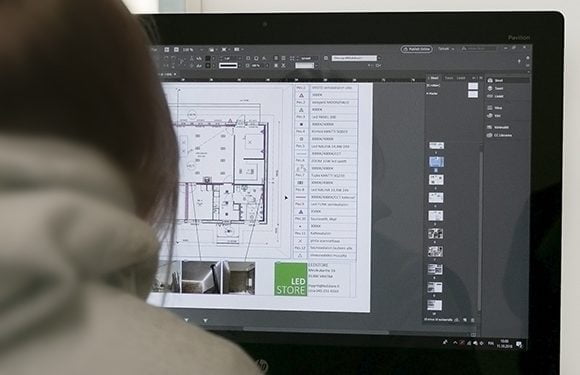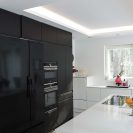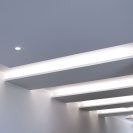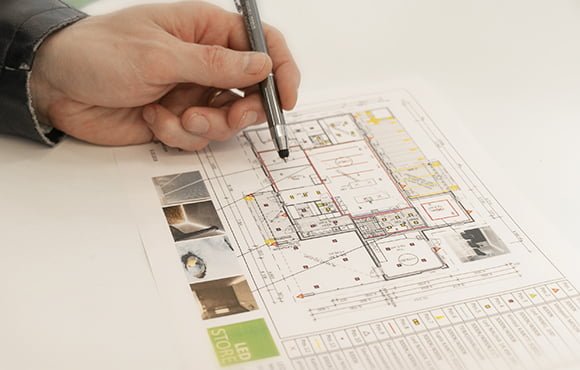Lighting design is an important step on the way of building or renovating a house and it is good to make plans sooner than later. Not a lot of people succeed in getting a perfect lighting for a big project by just walking in a (web)shop and by stacking up the trolley.
In this article we try to shine light on what to take into consideration when making lighting plans for your home and how can lighting design make things easier for you.
Lighting requirements of your home are the starting point of the lighting plans
What does your lighting designer usually want to know before starting:
- Are you building new or renovating old? With new buildings there are usually a lot less restrictions on how the lighting can be done, as when renovating, there might be quite a few things you need to consider.
- How do you want to use and control your lights? This includes for example dimming, colour changing, motion sensor etc. options. Usually is also good to know if you are planning on using ie. DALI, TRIAC or wireless controls.
- Requirements for the amount of light needed depending on the spaces and users? For example if some room might be marked as ”œstorage” on the plans, but will be used as arts and crafts room, the lighting designer needs to know that. Storage rooms and work spaces are lit very differently. It will also be good to know if some of the residents are hard of seeing or over 45, so that the amount and quality of light can be determined accordingly.
- How is the budget that is reserved for the lighting? A good rule of thumb is that the lights for the house cost approximately as much as the kitchen does. It can be more and it can be less, depending on the lights you want to use and how much extra you want to put in the plans.
- How and what do you want to light? Do you want indirect lighting, mood lighting, spot lights, lights that change colour from warm to cold etc. There are plenty of options!
Other thing to consider
How we experience of light differs from person to person. Some like brighter and some like darker spaces. Age also has its effects on the amount of light we need to see properly. These are just a few factors to take into account when starting to plan lighting.
We usually share the need for mood lighting, work lighting and general lighting. Lighting plays a big role on how we feel the spaces and how usable the spaces are, both emotionally and physically. By making smart solutions for different lighting set ups, it is possible to create comfortable and easily adaptable lighting with reasonable budget. All projects are different and have their own requirements, but with those requirements it is easier to plan a good lighting.

What background information is needed to create a good lighting plan?
When making the lighting design, it is important that the designer knows the measurements of the spaces, where there are windows and doors as well as how the ceiling is going to be build (angle, recessing possibilities, beams). Most of this can be seen on the basic plans of the house.
To make a successful lighting design, we need at least:
- Minimalistic led strip lighting on an architectural ceiling.

- Floor plans (preferably with measurements)
- Cutaway drawings
- Pictures of the facades (all sides)
Useful extras:
- Plans for kitchen, utility room and bathroom
- 3D pictures of the house (indoors and outdoors)
- Layout of the plot
- If it is a renovation project, pictures from inside are a must!
If possible, we recommend you to get the lighting plan done before you meet your electrician who will make the complete plan. This way you will save their time as well as your own time (and money).
If you are meeting with your designer, you can further discuss about the ceiling and wall structures before starting to plan. If you are building new, this discussion about structure is usually done after the first draft as the ceilings can be modified to suit your needs anyways. With recessed ceilings, the wires are not visible and lights look minimalistic as the are mostly hidden.
General lighting – using one type of light to create a united and minimalistic feel
By choosing similar kinds of lights to most of the spaces, you can create a lighting that looks and feels more united trough out the house. The light levels and lighting style will be more united and the look will be finished and minimalistic. It helps to choose lights that are similar in shape like round or square as well as in colour; white, metallic or black. Also having the same quality of light in all rooms is good (high CRI for example).
Lighting designers at LedStore can help you to select lights that go well together, give enough light to different kinds of rooms and to figure out what lights to use in more demanding spaces (high ceilings, work spaces etc.).
When renovating spaces it is good to let the designer know of any lights you want to include in the plans as what you would perhaps want to change. Most people have some lights they have grown to like and want to include in their lighting plans in both renovations and when building new.
Lighting design according to colours, materials and furniture
High quality lights guarantee that the colours of your interior look as they should and the lighting is safe and comfortable. It is good to plan the lighting of the spaces according to the use as well as furnishing. It always helps with the lighting design if you can determine the places of big furniture pieces like wardrobes and build-in shelving. You wouldn”™t want for example spots to be more off to one side of the room after the permanent wardrobes are installed, so it is better to have them already on the layout.
How does the interior colour effect the lighting?
If you are planning on having large, dark feature walls in your house, it is good to take into consideration when determining the lighting levels. Big, white glossy surfaces reflect light a lot, when dark, matte surfaces tend to make things dark. And there is also choosing of the colour temperature of the actual light. Unless of course you are going for CCT lights, where you can change the light freely between cool and warm white. We mainly recommend you to choose warm tones (3000K) for beige and brown interiors and neutral tones (4000K) with cooler tones like blues and monochrome interiors.
When is it time to select the colour temperature?
Mostly the light colour selection is done last (unless CCT), when you are almost finished the renovation or building and are entering the installation phase. We can include the recommended colours on the lighting design or the offer, if you wish. If you have the possibility to visit our shop, we highly recommend you do so, especially if you have selected wallpaper, colourful tiles etc. This way you can actually compare the difference that the change in light colour temperature makes in them. For example some greens look more olive on warm lighting and more bluish in neutral lighting. We are also happy to lend our customers some lights with different colour temperatures to take to the site to compare.
Lighting of the details

Spot lighting is an easy way to accentuate some features of your interior. LedStore has different solutions on highlighting architectural features, functions and accent walls.
Led strips can be used to highlight longer straight lines, recessed ceilings and staircases in a subtle way quite easily. Paintings, accent walls and special wall structures are more often lit with spot lights. To light pictures and sculptures, we recommend you to use our ZOOM spot, that has an adjustable light beam (in size).
When using spots on some areas, it is good to make sure that also other areas of the space are well lit and the lighting is balanced. Our lighting design will make sure of that.
Lighting design for different rooms of the house
Different rooms need different amount of light. Planning lighting according to the use of the rooms guarantees that you”™ll have perfect lighting for every function. That is why you”™ll want to use the lighting designer.
Well lit work spaces are a must
Work spaces like kitchens, utility rooms, hobby rooms and home offices should be well lit and with minimum glare. This way you can easily see what you are doing without having to squint. Working is so much nicer when there is enough light and your eyes won’t have to work hard to see.
Perfect colours
People who cook a lot as well as people doing arts and crafts or photography know that the quality of the led chip really matters. If you are working with colours, or with food, you want the colours to look perfect and the colour that you intended them to be. Especially with photography, look for lights with the minimum CRI of 95. Also if you can, ask for the graphs that tell you the value of all the different colours measured, so you can see if some of the colours are missing. Most of our lights have the test reports as pdf-files included on the web site. CRI is a mean value of the 15 colours measured. High quality light is also good for spaces where you do your makeup and choose your clothing, like walk-in closets.
Work spaces are recommended to be in between 500-800 lux in power. For private housing, the calculations are done by estimate as most spaces also have dimming. With dimming, it is better to have a bit more light than actually needed, so there is something to dim from. So on those darkest days of the year, you can have enough light to feel good.
Minimising glare
For general lighting for work spaces we mostly would recommend panel lighting as the light is very even with virtually no glare. Panels usually are also bright, but the brightness is divided on a much larger surface than in a spot light. Led strips are used to provide lighting for kitchen countertops as they can be installed in a continuous line. When selecting a strip for kitchen, we recommend strips with 120 leds/m minimum if you use a very slim profile. This way the leds will not show as dots, but as a continuous line of light. You might not see the actual strip while standing next to your countertop, but in most kitchens, you will see the reflection of the strip on the countertop.
Let us know about your specific lighting requirements, so we can include some good solutions for you in your lighting design.
Where to use dimmers?
Dimming gives an extra comfort to living. We recommend to used dimmers on the rooms that you spend most time or in the spaces you want to be bright during the day and dim during the night. Most of our lights are dimmable and dimmers can also be added later. Wireless dimmers can be used in spaces like bedrooms, where you want to be able to adjust the lights remotely, from your bed. Wireless dimmers are useful on renovation projects where installing a basic dimmer is not possible. Wireless dimmers can also be added to old existing lamps. Do not hesitate to ask us for help when in doubt!
Livingroom
- is the space that dimmers are mostly used at as you spend most of your time there. During the day, it is nice to have bright lighting but during the evenings it’s good to be able to enjoy the cosy, dimmer lighting.
Bedrooms
- can also profit from dimmers. Early mornings and late nights the lighting can be set to low and when cleaning or putting away laundry, set to bright. Also wireless dimmers are handy, as you can control your lights without getting out of bed.
Childrens rooms
- are also good places to use dimmers as you can differentiate the active and peaceful times by adjusting the lighting. Note that you can also do this by having a bright general lighting and cosier lighting (created by table or floor lamps).
Spa style washrooms
- gain a bit of extra luxury by dimmable lighting. Mostly this is created by brighter (maybe non dimmable) general lighting combined with led strips that create indirect soft light. In these cases the led strip is most commonly connected to a dimmer. Having the lights on a different switches allows you to also control the scenes easier.
Lighting design at LedStore – we know our products
Modern led lighting might be hard to handle by yourself, so do not hesitate to ask us for help. We will find you the right solution for your spaces and needs. There are plenty of dimming options and combinations to use to achieve a perfect lighting for you. Our collection has high CRI lights, dimmable lights, water resistant lights, CCT adjustable lights, RGB lights and more. So let us know your hopes, needs and requirements for the lighting and we’ll help you to select the right lights for your project!
Read our earlier blog posts about lighting:
- Outdoor led lighting (link to a blog post)
- How to choose the right led strip? – helpful tips (link to a blog post)
- Choosing the right colour temperature (link to a blog post)
- When to use a dimming switch with led lights? (link to a blog post)
- VaLO – wireless controls for lights (link to a blog post)

